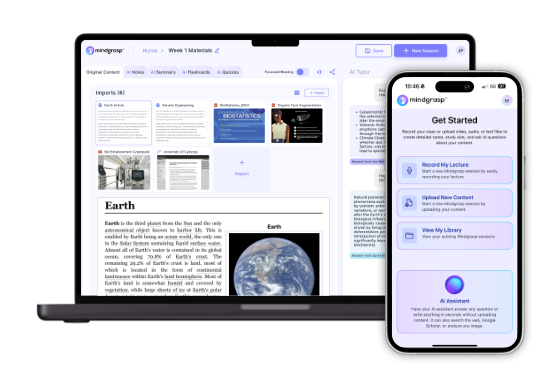
Cramming for a language exam isn't ideal, but we've got your back!
First, prioritize high-impact topics like frequently tested grammar rules and core vocabulary. Gather your materials and create a quick study plan targeting your weak areas.
Use active recall (flashcards, self-quizzing) instead of just rereading notes, and visualize complex grammar with simple diagrams.
Take short breaks every 30 minutes, and focus on all four skills: reading, writing, listening, and speaking.
The strategies below will help you maximize those precious remaining hours.
Why cramming for language feels harder than other classes
While many of us have successfully pulled all-nighters for history exams or math tests, language cramming feels like trying to stuff a week's worth of groceries into a tiny fridge. Why? Language learning isn't just about memorizing facts—it's juggling four distinct skills at once: reading, writing, listening, and speaking.
Unlike cramming for math (where formulas rule) or history (hello, date memorization), languages demand more from our brains. We can't just memorize vocabulary lists and grammar rules; we need to understand how everything fits together contextually.
Think about it—knowing what "bonjour" means doesn't help if you can't use it in a real conversation!
The truth is, languages require practice and application. When we try cramming, we might remember things short-term, but we won't develop the lasting proficiency we need.
Boost Your GPA Faster with Mindgrasp
Instantly turn your class notes into smart summaries, flashcards, and quizzes—study less, learn more, and ace your exams.
Try it FreeStep 1: Determine what to study (Prioritize high-impact topics)
Before you plunge into cramming for your language exam, you'll need a clear battle plan—and that starts with figuring out exactly what deserves your precious study time.
We recommend looking at your past exams first—where did you lose the most points? Those weak areas should top your list. Check the exam syllabus too; it's basically a treasure map showing what your instructors value most. Old tests can reveal patterns (they love testing the subjunctive tense, don't they?).
When creating your study schedule, prioritize high-impact topics that:
- Appear frequently on exams
- Carry more weight in scoring
- Previously tripped you up
- Your teacher emphasized in class
Don't waste time studying everything equally—that's a rookie mistake! Focus your energy on what'll give you the biggest grade boost.
Step 2: Gather your language materials and make a quick plan
The next three hours of your language exam prep will be dramatically more effective with the right materials at your fingertips.
Let's round up everything you'll need:
First, collect all your language materials—textbooks, notes, flashcards, and those audio recordings you've been ignoring. Having these organized in one place saves precious minutes when you're racing against the clock!
Next, create a quick study plan that tackles your biggest weaknesses first. Remember that practice test where you bombed the listening section? Yeah—that needs extra attention.
Divide your cramming time between all four skills: reading, writing, listening, and speaking.
Group similar topics together (all those pesky verb tenses in one pile) and set small, doable goals for each session—like mastering 20 vocabulary words in 30 minutes.
Step 3: Use active recall to study language (Don’t just re-read)
Now that you've gathered your materials, let's talk about how you'll actually study them. The biggest mistake we see students make is just re-reading their notes over and over. That won't cut it! Instead, you need to use active recall techniques.
Here's what works better:
- Create flashcards for vocabulary and flip them often
- Write out verb conjugations from memory (not copying)
- Speak sentences aloud without looking at your notes
- Quiz yourself on learning grammar rules instead of reviewing them
Your brain remembers what it has to work for. When you force yourself to retrieve information—rather than just recognize it—you're creating stronger mental connections.
Trust us, this approach might feel harder, but you'll remember so much more when exam time comes!
Step 4: Break down complex language processes with diagrams
Complex grammar and vocabulary can feel like a maze when you're cramming, which is why diagrams are your secret weapon!
We've found that turning abstract language rules into visual aids helps information stick better in those pre-exam cram sessions.
Try these diagram techniques:
- Create flowcharts for tricky grammar rules (like when to use subjunctive vs. indicative mood)
- Draw mind maps to organize vocabulary by themes or situations
- Sketch sentence structures to visualize how words connect
These visuals work because they transform complicated language patterns into something you can actually see.
Plus, the act of creating diagrams engages different parts of your brain than just reading does. When you're short on time, these visual shortcuts can make all the difference!
Step 5: Leverage AI study tools like Mindgrasp AI for language
While traditional study methods have their place, modern language cramming calls for smarter tools in your arsenal! AI study tools for language students like Mindgrasp AI can transform your last-minute prep by creating personalized study plans that adapt to how you learn best.
Try Mindgrasp for Free!
Experience an easier, faster way to boost your GPA. Sign up now to try Mindgrasp AI for free and see how AI-powered learning transforms your study routine.
Try it FreeInstead of wasting precious study time on concepts you've already mastered, Mindgrasp identifies your weak spots and focuses your efforts there.
We love how it:
- Gives instant feedback on vocabulary, grammar, and pronunciation
- Uses spaced repetition to help you remember words when you need them
- Creates custom quizzes targeting your trouble areas
- Combines videos and audio clips for more engaging learning
Think of it as having a tutor who never gets tired and knows exactly what you need!
Step 6: Memorize key terms and definitions with flashcards & mnemonics
When time is running short, flashcards and mnemonics become your secret weapons for language exam success!
We've found that writing vocabulary terms on one side and their definitions on the other creates the perfect tool for active recall. Here's how to maximize their effectiveness:
- Organize your flashcards by topic (conversation, travel, food) to focus on weak areas
- Create memorable mnemonics that link new words to concepts you already know
- Quiz yourself regularly, setting aside 15-minute sessions throughout the day
- Use the spaced repetition technique—review cards at increasing intervals
Don't have time for physical cards?
Try digital flashcard apps that let you study on your commute or during breaks. They'll track your progress and remind you which vocabulary needs more attention!
Step 7: Practice with questions and problems
Now that you've built your vocabulary arsenal, it's time to put your language skills to the test! We strongly recommend digging into past exam papers and sample questions to get comfortable with what you'll face on test day.
Try these proven strategies:
-
Time yourself while working through practice questions — this builds your speed and confidence
-
Mix up question types (reading, grammar, writing) to strengthen all aspects of your language skills
-
After each practice session, review your mistakes carefully — they're your best teachers!
Step 8: Take short breaks and look after yourself
Practice is intense, but your brain needs time to recharge! Research shows that taking 5-10 minute breaks every 25-30 minutes dramatically improves your language retention.
During these breaks, try:
- Standing up for a quick stretch
- Taking a short walk around the room
- Drinking water (stay hydrated!)
- Eating a small, healthy snack like fruit
These mini-breaks aren't wasted time—they're actually helping your brain process all those vocabulary words and grammar rules.
Plus, they'll keep your stress levels manageable during your cramming session.
Cramming for language in 1 Day, 3 Days, or 1 Week
We'll tackle three different cramming timelines to help you succeed on your language exam.
If you've got a full week, you can set up a daily schedule covering all language skills with regular practice tests.
While three days calls for focused grammar review and vocabulary memorization with flashcards.
With just 24 hours left, don't panic—concentrate only on high-impact vocabulary, essential grammar rules, and quick listening exercises that'll give you the biggest return on your limited study time.
Cramming for language with one week left
With one week to go before your language exam, you've got just enough time to make significant progress if you're strategic. The key to effectively studying for language exams is managing your time wisely.
We recommend breaking down your material into daily chunks — dedicate specific days to grammar, vocabulary, and practice questions.
Don't just read passively! Test yourself using flashcards and actively recall what you've learned.
Here's what works:
- Create revision cards for key vocab and grammar rules
- Review difficult concepts several times throughout the week
- Take mock tests to simulate exam conditions
- Use spaced repetition to strengthen memory
Cramming for language with three days left
Three days until your language exam? Don't panic – we've got this! It's time to get strategic with your cramming efforts. Focus on high-frequency vocabulary and essential grammar rules that'll give you the most bang for your buck.
Break your study time into manageable chunks:
-
Morning: Review vocabulary flashcards using active recall
-
Afternoon: Practice grammar exercises on trouble spots
-
Evening: Take mini mock tests to simulate exam conditions
Remember to schedule short breaks between sessions – a quick 5-minute walk or snack break keeps your brain fresh!
Test yourself constantly rather than just re-reading notes. When you actively recall vocabulary, it sticks better in your memory.
The clock's ticking, but with focused effort, you'll be ready on exam day!
Cramming for language with one day left (24 hours)
So you've waited until the last minute – only 24 hours remain before your language exam! Don't panic, we can still make the most of your cramming session.
First, focus on high-yield topics that frequently appear on tests – core vocabulary and essential grammar rules are your priorities now. Break your study time into chunks: 30 minutes for reading, 30 for writing, and so on.
Instead of passively reviewing notes, use active recall techniques – quiz yourself on vocabulary and grammar points. It's way more effective!
Listen to audio materials in your target language to sharpen your comprehension skills.
Remember to use spaced repetition – review vocabulary multiple times throughout the day at increasing intervals. This method helps lock information into your memory just in time for the exam!
Common mistakes to avoid when cramming and how to fix them
Despite your best intentions, cramming for a language exam can quickly go off the rails if you're not careful about your approach. We've noticed that many students make common mistakes when trying to absorb grammar and vocabulary at the last minute. The biggest error? Trying to cover too much at once! Instead, break language topics into smaller chunks – maybe focus on just one tense or a specific word group.
Another trap is passively rereading notes. This feels productive but doesn't stick! Try quizzing yourself or explaining concepts aloud.
Don't forget to prioritize your weak areas – is your listening comprehension shaky? Work on that rather than reviewing what you already know. Remember to take short breaks to prevent burnout, and space out your review sessions for better retention.
Final Takeaways on language cram studying
While cramming for a language exam isn't ideal, we've shown you how to make the most of your limited time. Remember that breaking material into manageable chunks and setting specific goals are practical tips that will help you navigate through last-minute studying.
To manage your time effectively, focus on targeted topics rather than trying to cover everything. Combine active recall with spaced repetition – even in short bursts – to lock that vocabulary into your memory. Why not record yourself saying key phrases and listen while doing other tasks?
The most important takeaway? Cramming works best when it builds on some consistent practice you've already done. Think of cramming as reinforcement, not replacement – your brain needs those connections to make the information stick when exam day arrives.
Download Mindgrasp from the App Store
Access Mindgrasp at your desk for in-depth research and writing projects, or use the mobile version to easily access your content on-the-go or record live lectures.
Download the iOS App
